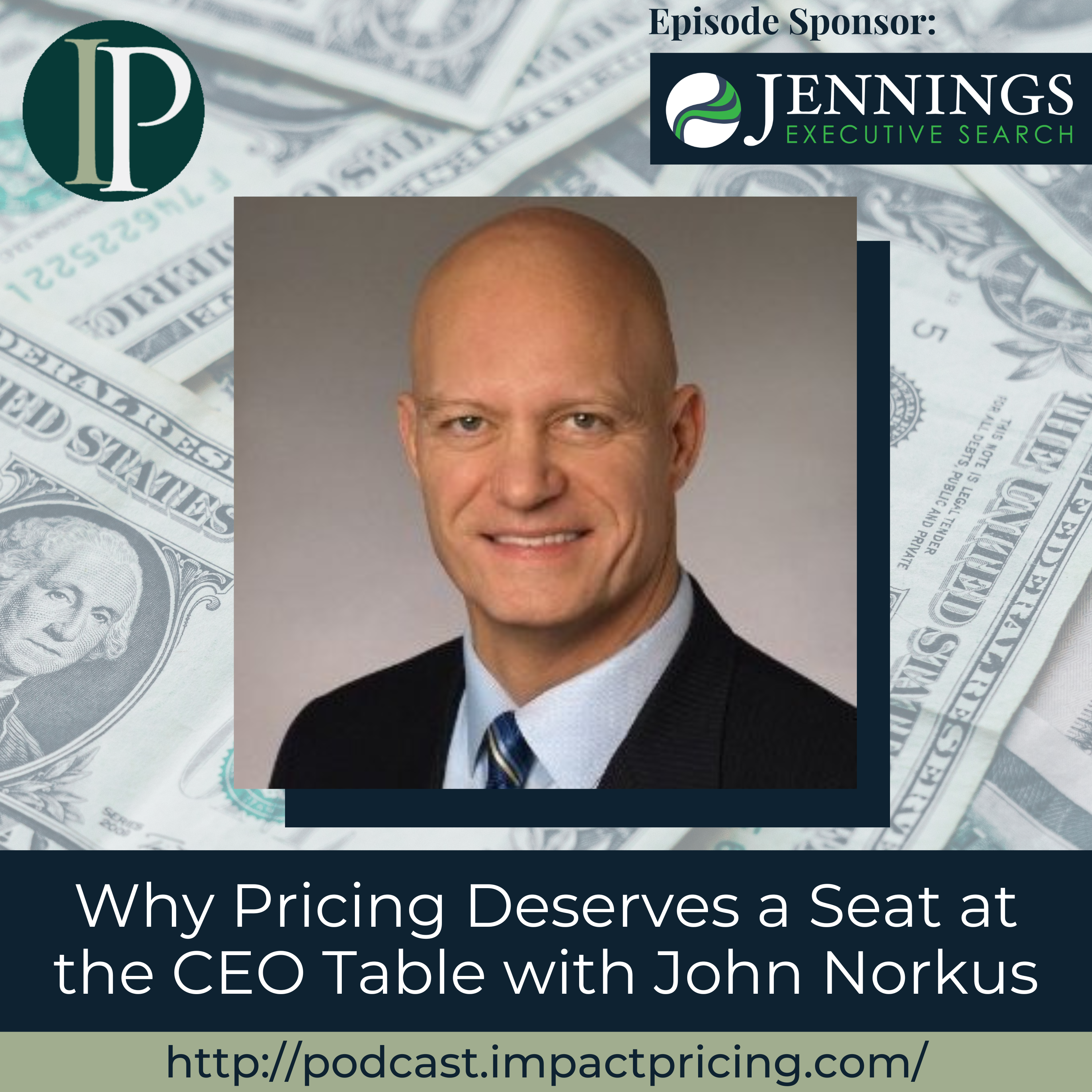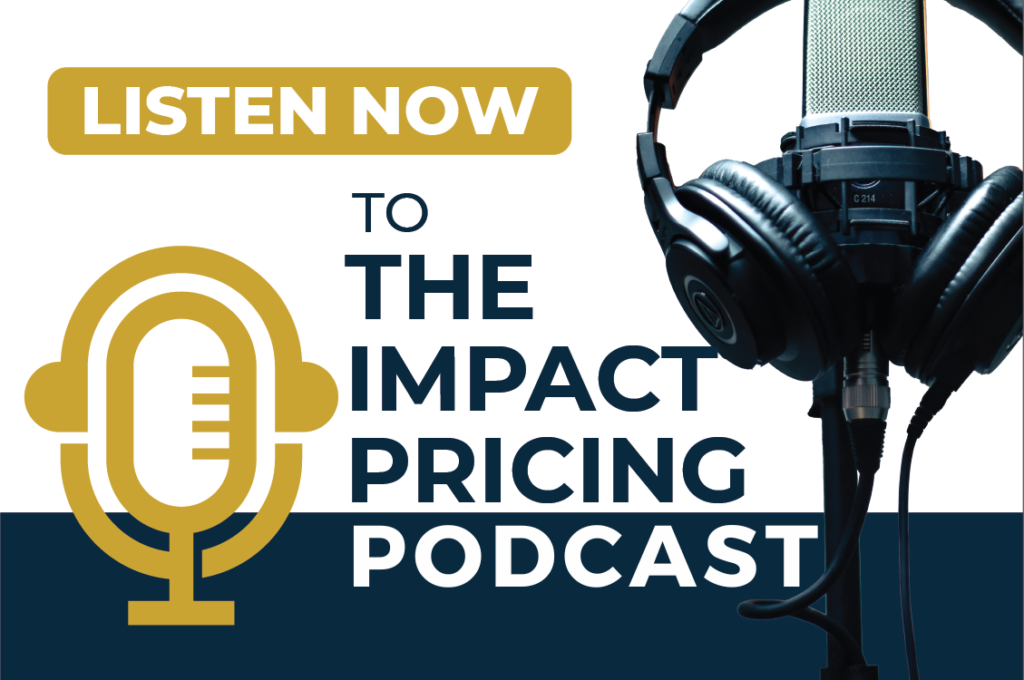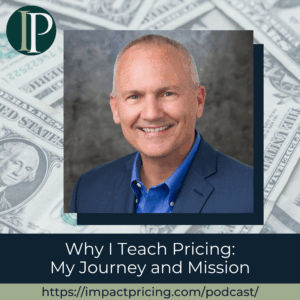
In this episode, John makes a compelling case for why pricing professionals deserve a seat at the executive table, exploring the disconnect between pricing’s impact on enterprise value and its typical organizational placement. He discusses his new platform designed to unite senior pricing professionals and elevate the discipline to C-suite recognition.
Podcast: Play in new window | Download
Why you have to check out today’s podcast:
- Discover why pricing professionals are typically buried 2-3 levels below the CEO despite controlling one of four key profit drivers.
- Learn the difference between traditional pricing roles and true chief pricing officer responsibilities.
- Understand how to position pricing as enterprise value creation rather than just cost management.
“Pricing may be part marketing, part analytics, part behavioral, part external, part internal, but it is the piece that aligns us on how we’re actually squaring off against the market.”
– John Norkus
Topics Covered:
01:43 – John’s journey to pricing transformation: From aircraft engineer to behavioral economics and CRM to pricing strategy
05:18 – Positioning pricing as organizational connective tissue: Why pricing deserves equal footing with volume, cost, and mix initiatives
08:01 – The pricing control dilemma among departments: How sales, marketing, finance, and operations all claim ownership of pricing decisions
12:24 – Defining the Chief Pricing Officer’s role: Executive alignment versus operational pricing work and transformation implementation
15:45 – Pricing strategies in business: Inside-out versus outside-in approaches and competitive intelligence versus customer willingness to pay
16:32 – Critical senior alignment in pricing projects: Why CEO buy-in as a top-3 initiative determines transformation success or failure
19:39 – Pricing and enterprise value analysis: Demonstrating 2-7% bottom-line impact within 12-18 months to justify executive investment
23:35 – The activist CFO and enterprise value: Finding CFOs who understand value creation beyond cost reduction and margin improvement
29:29 – Pricing as organizational alignment: How pricing serves as the ultimate test of market positioning and competitive strategy
Key Takeaways:
“If the pricing transformation of the pricing program isn’t number one on the CEO’s list of one, two, or three most important thing they can do this year… then quite frankly, it’s not as important and it doesn’t have the kind of alignment that you thought it did.” – John Norkus
“Organizations who get it are the ones that we should be engaging with… change comes from within. And if somebody believes that this is the right thing to do and they just need somebody to help them do it and somebody who has done it before, that’s where people like you and I actually succeed.” – John Norkus
“I consider 20% of everything we do in pricing to be analytics or data and objective based, and the other 80% to be about behaviors, either internal behaviors or external behaviors that need to be captured and understood.” – John Norkus
Resources and People Mentioned:
- Professional Pricing Society (PPS): https://www.pricingsociety.com/
- Simon Sinek: https://simonsinek.com/
- Four Drivers of Enterprise Profit: Volume, Cost, Mix, and Price – and their typical organizational reporting structures
Connect with John Norkus:
- LinkedIn: https://www.linkedin.com/in/johnmnorkus/
- Email: [email protected]
- Website: https://www.chiefpricingofficer.com/
Connect with Mark Stiving:
- LinkedIn: https://www.linkedin.com/in/stiving/
- Email: [email protected]
Full Interview Transcript
(Note: This transcript was created with an AI transcription service. Please forgive any transcription or grammatical errors. We probably sounded better in real life.)
John Norkus
Pricing may be part marketing, part analytics, part behavioral, part external, part internal, but it is the piece that aligns us on how we’re actually squaring off against the market.
[Intro / Ad]
Mark Stiving
Welcome to Impact Pricing, the podcast where we discuss pricing, value, and the presumptuous relationship between them. I’m Mark Stiving, and I run boot camps to help companies get paid more. Our guest today is John Norkus. Here are three things you want to know about John before we start. He is the founder of chiefpricingofficer.com, which is what we’re going to talk about today. He’s led pricing transformation teams at several large consulting companies like Deloitte, KPMG, and possibly my favorite thing, he started out as an aircraft engineer. Welcome, John.
John Norkus
It’s great to be here, Mark. Thanks for having me.
Mark Stiving
How’d you get into pricing?
John Norkus
Wow. I think that my journey to pricing is different, just like everybody else, which is started out in engineering because I love to figure out how things work. And after spending some brief time designing aircrafts, went on to get my B-school degree.
And without draining my resume, I have always been very interested in how things work and fascinated by how business works, especially when we start getting into the behavioral economics pieces of it. Why do people make decisions that they make? How is it that certain groups are going to decide one way versus another? And that led me to CRM and ultimately led me to pricing.
CRM was an interesting way to springboard me there because I’d always heard that the promise of CRM was treating different customers differently. But ultimately, treating different customers differently leads to the behavioral economics that leads to pricing, actually putting a number on treating people differently. That’s what led me to my career.
Mark Stiving
Love the story. I’m a recovering engineer as well. And I think the reason that I fell in love with pricing is because it’s a number, but it’s not really a number, right? It’s not really calculatable.
John Norkus
Exactly. There is a mystery involved in what pricing is all about. And that constant pursuit of how does this work? I think is what we hold in common and what we, all of us as pricers actually feel like we’re always in pursuit of.
Mark Stiving
Yeah. So tell me about chiefpricingofficer.com. First off, how long ago did you start it? It looked like it was relatively recent.
John Norkus
Right. So it’s been live now for two months. And here’s see if I could make this long story short. I’ve retired now from two large big four consulting firms. And in doing so, I thought that the best capstone on my overall career would be to elevate and celebrate pricers. Those who have been to a great extent marginalized in terms of their overall value to the value of the enterprise.
So how do I do that? Well, continuing to network, I started to blog and I was creating articles around the subject of pricing until it finally dawned on me that we’re really not speaking as one voice. Everybody is out there doing their individual articles and their individual blogs, but there’s no one organization. And I thought on a whim, oh my goodness, how expensive and who already owns the notion of chiefpricingofficer.com? Nobody owned it. And I said, here’s an opportunity for us as a group to claim our space. And let’s start speaking with one voice.
There’s a variety of things that we talk about as pricers that if we talked about it as a group would have that much more weight associated with it. So to bring this to conclusion, if you think about the four drivers of enterprise profit, volume, cost, mix, and price. And then take a look at where they report to in an organization. Who reports to the CEO? Well, gee, volume, your chief revenue officer does. Cost, your chief financial officer does. Mix, your chief marketing officer or your chief product officer does. And then price? Oh, wait a minute. In most organizations, it’s two or three levels down.
And so we need to speak with one voice about, one, how much value we produce, and then, two, how we are the connective tissue of the enterprise. And that’s what chief pricing officer is all about.
Mark Stiving
Okay. First off, know that I agree with you, but I’m going to push back like heck here.
John Norkus
Love it. Love it.
Mark Stiving
So first, why do you think pricing doesn’t get a seat at the chief executive’s table? What is it about pricing that’s so weird?
John Norkus
I’m going to start first things first with, I don’t think we as professional pricers are doing ourselves a whole lot of favors. And because it’s difficult to understand, as we talked about, as we were making the introduction, which is pricing might be so many different things to so many different people.
And so when asked the question, “Oh gee, you’re a pricer. So what is it you do?” You might come across as an academic. “Well, that’s all theoretical. It has nothing to do with what I do in the field.” It might come across as too analytical. “Well, you’re breaking down the transaction and that’s not really what I’m all about.” It might come across as some sort of wizard. “I show up on a semi-annual basis and show you how you’re performing versus how you’re not performing.”
It might be seen as a mercenary. “You know what? I love the pricing guys and the tax guys because the pricing and tax guys on an annual basis show me where I can go get some money in order to make my year end.” Or it might come across as someone who is trying to make this large fundamental transformation that the organization really isn’t too comfortable in doing. “Oh, here comes the change agent.” And therefore, we already have the barriers being placed up in front of it.
And so we as pricers have an opportunity to talk about the ongoing value that we produce and then be very specific about that as the connective tissue in the organization. And I’ve been looking for the best metaphor in order to portray that. And that’s where I’m struggling and quite frankly, what I see myself doing in the near term.
Mark Stiving
Okay, I’ve got two other possible reasons why pricing is not well-respected or lifted up. First one is, I think people look at pricing as a number. And it isn’t, right? It’s so much more than a number. And so the question is, how do we get that message across that says, look, it’s really packaging. It’s really understanding how do customers perceive the value of our products. It goes into market segmentation. There’s tons of things that are super relevant to what we do. But if you see it as a number, it’s like, who cares? It’s not that important.
And then here’s the second one that I think is even bigger. And that is everybody in the company cares about pricing. And so you don’t get a big seat at the table because they want their control over pricing, right? Sales wants control, marketing wants control, production wants control, finance wants control. Everybody wants to control pricing. What do you think?
John Norkus
I agree with both. It’s easy to dismiss pricing or marginalized pricing when you’re only looking at a number and thinking about it in terms of a transaction. And it’s also very easy to where everyone’s a critic and no one’s a chef, right? Make my food better. Go. That’s a tough one to get a hold of.
And therefore, those of us who have been successful in pricing are those who understand the relationships first. When we talk about the perplexing nature of pricing, I find that it has to, if there are good relationships among the corner offices, and if there’s a CEO who actually believes that that’s the way it’s going to work, they are outperforming their competition significantly. And that’s where some of the research that I’m starting to do is going, which has to do with the mindset in the corner offices and the outperformance as a result.
Mark Stiving
So how do you view Chief Pricing Officer as different from PPS?
John Norkus
ChiefPricingOfficer.com, and if PPS, you mean Professional Pricing Society…
Mark Stiving
Yeah, sorry.
John Norkus
First things first, Professional Pricing Society is extraordinary in their ability to pull pricers together to have conversations about the nuts and bolts of what pricing is. ChiefPricingOfficer.com is there for those who have all of the experience, the scars on their back. They’ve spent at least two decades doing this. They have worked in an executive suite and understand the dynamics of managing an executive suite. And so it is a group that is focused on advancing enterprise value. And it’s a group who have an executive presence that can do so. So did that help?
Mark Stiving
It did actually helped a lot. But as you talk through that, I find it so much easier to deal with pricing at small and midsize companies than I do at enterprise level companies. Right. And it might have to do with exactly what you’re talking about.
John Norkus
It is. When you have entree to a CEO and a small group of senior leadership, it’s easier to have a conversation among four or five who are, for lack of a better term, hungry in order to get to their growth and align on that one than it is to work in large corporations who hit you with the soundbite, “Well, we’re going to price for growth.”
Really? Growth of what? Growth of profit? Growth of your bottom line, growth of revenue, growth of product introduction, what does growth mean? And it tends to get lost while at the same time, we find very many pockets of pricing without anything that’s being done in a more formal way in the larger companies versus those that are midsize. And by midsize, I think we’re saying $250 million to about $10 billion, which can actually then focus on making pricing an integral part of their model.
Mark Stiving
Yeah. So what point in time do you think a company needs a chief pricing officer? What revenue level?
John Norkus
While certainly pricing should always be part of the conversation, what I’m finding and what I’m seeing is there’s this introduction of partial or fractional, if you will. I don’t want to use the word fractional because it looks too much like an analytics, like a box checker, but partial or fractional chief pricing officers that are able to visit.
And so when we start getting into something that can be defined as not the CFOs, challenge and not the CMO’s challenge. It’s too much for them to do. On a case-by-case basis, that can be determined whether or not you need the care and feeding associated with the chief pricing officer, whether or not it needs to come in in a more fractional sense.
But quite frankly, when the CEO says, “Everybody’s paying attention to this, therefore nobody’s paying attention to this. And I’m going to put somebody into my quarterly meetings and meet with them on a weekly basis” is the moment that you need a chief pricing officer. By the way, you don’t have to call them that. And that’s the funny thing about chiefpricingofficer.com. Just about nobody in the organization so far has that title, but they’re doing it.
Mark Stiving
Yeah, that’s because if you use CPO, everybody knows that’s Chief Product Officer.
John Norkus
Correct. Or Chief Procurement Officer. I’ve run off with CPOs where they’re like, it’s all about procurement. It’s like, no, well, the Chief Procurement Officer actually is 15 years ahead of where Chief Pricing Officer is trying to be now.
Mark Stiving
Yeah, exactly. Exactly. So let’s talk about inside out versus outside in for just a second. Okay. And so when I look across companies, what I almost always see is everybody’s focused inside out. And I mean, everybody, including marketing. And yet pricing is like, Hey, I’ve got to know how much this buyer is willing to pay. So we’re looking outside and it may be the only group that looks outside in, even though marketing should be, you know, product development should be, everybody should be, but we may be the only group that really is. Go ahead.
John Norkus
I agree with that with a caveat. And here’s the caveat. Many organizations call me in and say, “Take a look at my pricing because for the first time, I want to start collecting competitive intelligence.” And if that’s what you’re looking to do, then please don’t call upon a professional pricer in order to do that. There are many bureaus out there that will go ahead and try to do the screen scraping or the data collection agencies associated with competitive intelligence.
And to a certain extent, please also don’t think that that house is somehow going to give you grand information on your pricing, especially in a B2B environment. There is an inside-out necessity when you’re doing pricing work because you need to understand the behaviors associated with your selling motions right now. And make no mistake, selling motions have a lot to do with how you’re able to affect price within the marketplace.
But to align with you on your question and the assertion that, yes, we’re the first organization that is asking the question about clients’ willingness to pay. And probably in many cases, asking the first question about, “Well, given that, why don’t we start segmenting? Why don’t we start focusing on those that are your best customers so that we’re stopping this wasting of time and wasting of a lot of money on those that you think every transaction is a good transaction. Every dollar is a good dollar.”
It’s a difficult conversation to get into because to your earlier point, you’re starting to then pick at those who think that they own pricing like the field.
Mark Stiving
So what’s the difference in the conversation we’ve had so far? It feels to me like the huge difference between someone at a large enterprise company and someone, I’m going to say the words doing pricing, which you may not approve of, is hugely different because the chief pricing officer feels to me like their job is managing all the other executives. Whereas in pricing roles, our job is to go out and listen to the market and understand customers’ willingness to pay and actually teach salespeople how to sell value. I mean, there’s a lot of things that we do as pricing people that I don’t see chief pricing officers would actually do.
John Norkus
And so you’re doing a great job of differentiating when we get into pricing or price transformations, the difference between executive alignment and the more operational or transformational implementation of what some of us pricers are doing.
And so what I’ve found when doing projects like pricing projects is that alignment is extraordinarily important to the overall success. When we take a look at what typically drowns a project like a pricing transformation project, it’s not necessarily that the analytics aren’t good. They’re great. It’s not necessarily that we don’t understand the kind of sales motions that have to change. It has to do with the senior alignment.
And what I’ve come to find is that if the pricing transformation of the pricing program isn’t number one on the CEO’s list of one, two, or three most important thing they can do this year, and then number two, if it somehow then gets marginalized if a crisis comes up, then quite frankly, it’s not as important and it doesn’t have the kind of alignment that you thought it did. And therefore, in its inception, maybe this wasn’t the best project because it’s not gonna lead you to good things. That’s where I see most of these projects falling down has to do with their senior alignment.
So if your assertion is a chief pricing officer is somebody that’s actually the connective tissue among senior people, the answer’s yes. And in order to be successful, all of the pieces that go underneath that up to and including actually teaching the sales organization new sales motions are. The activity is necessary for the overall execution of the program.
Mark Stiving
Yeah. So as you were talking, what jumped into my head is I could imagine trying to go to a CEO and make pricing one of the top three projects or the top three initiatives. But what does that mean? Right. That’s like the hardest question to answer. How do you go to a CEO and say, pricing’s got to be one of the top three initiatives we do this year?
John Norkus
Well. I don’t mean the following to sound like a cop out, but what I have found, if you take a look at the technology adoption curve and the Simon Sinek and he talks about getting people on board, what I have found is organizations who get it are the ones that we should be engaging with.
And in all vulnerability right now, I’ve been drawn into a variety of corporations where they say, “You know what, your first job is to go convince the senior people that this is the right thing to do.” And I have found that actually in many cases and in most cases, that’s not the thing to do because they already have their top three. And change comes from within. And if somebody believes that this is the right thing to do and they just need somebody to help them do it and somebody who has done it before, that’s where people like you and I actually succeed is in most cases.
Well, you see the breakdown of the technology adoption, right? The top one or 2% already think it’s the right idea and are already doing it. The next 16 to 18% are those who are excited about the idea and want to know that somebody else has done it and is looking to then what are the applications? How do I get started? And then you’re going to find your mainstream.
And your mainstream is that 70% that says, “You know, before I start and before I think this is the right idea, I need to know that you’ve done it in my industry before. I need to know that it’s been done two or three times. I need to know that your team are the ones who have done it. And quite frankly, I need something else that’s going to be this X factor because I don’t think I’m going to move until I see the rest of the market moving in that direction too.”
And so my assertion on all this is that pricing is at the moment of jumping over the chasm, right? That the great chasm between that first 20% and the remaining 70 to 80% that say, “This is the right thing to do. And I’m going to be reluctantly compliant to what my chief executive has told me I’m going to be going to do.”
Stiving
Yeah, I’m not sure I agree with that. Not that I disagree, but I’m not sure I agree with it in the following sense. Because pricing, it seems like a common theme of what we talked about today is this word pricing is ambiguous and no one really knows what it means and we have to try to explain it. And so because of that, it seems really hard to get executives to say, hey, we’re going to go do pricing.
But when I think of what pricing is, and let me think of it as understanding how is it the customer’s perceived value. So we can get the value of what it is that we’re delivering. So you could argue that’s a marketing problem, right? So we’re going to go focus on that in marketing, or you could argue that’s a sales problem. We’re going to go focus on that. And how do we sell the value? Well, you could argue that’s a product development problem where we haven’t built the products that capture the right value from our customers. And so, so it’s, once again, I think we’re buried in these other departments where they don’t think the way we think and they should.
John Norkus
Let me try another one, which is, right, so you asked the question, how do you convince somebody that it’s the most important thing they can be doing? And one way of doing that is by demonstrating the enterprise value. There are plenty of case studies and plenty of enterprise value analyses that can be performed that says you can drop two to 7% to your bottom line within 12 to 18 months if you are able to take on a project like this. And if there is a CFO, CEO combination that says, “You know what, this is about producing value, we can do that as pricers.” if they believe that that is the number that they are chasing.
And so it’s interesting in how very specific we can be when putting together a program like this. And so what I need is a CEO CFO combination that says, “This is what I think we’re going to be doing because we’re going to be producing the value.” And you know what? Those of us who have done it before. I’m willing to bet part of my fees on that outcome because when we do some of these things, there are so many hygienic things that we can do to put stuff on the bottom line, simple discipline things that we’re going to go make the money back for the corporation.
But that begs the next question. Well, then why aren’t they doing it? And it’s because, yes, it’s buried two or three layers down within the organization. And they have to come in and make some of those activities and some of those motions change. But again, we’ve done this before and we’re willing to do it. So how do we remove the ambiguity, make it into an enterprise value number, and then chase that number together?
Mark Stiving
Yeah, nice. So you brought up CFOs several times today. I always, in my mind, imagine that CFOs have the authority or ability to say, look, let’s pursue more margin. Let’s drive this. But I never get the feeling that they have the insight that it’s around the value side. It’s not around the cost side. Is that wrong or?
John Norkus
That’s absolutely right. And the CFO, talk about some of the marketing that I and my friends are doing, the marketing is done around what we’re calling the activist CFO.
Mark Stiving
Okay, say that more clearly, the activist CFO.
John Norkus
Well, who is an activist CFO? Go back to the technology adoption curve, which is, it’s that 16 to 18% that said, “Boy, if I could just get a CMO who believes that they know how to differentiate within the marketplace, I can go make that money. And then I need somebody who’s actually going to be the connective tissue to be able to weave it all together into a fabric that is, again, not mercenary, but sustainable in producing enterprise value, that’s the CFO that I’m looking for.”
So there are a number of CFOs out there that realize that their role is not just the numbers and not just the cost side of it, but are seeking ways of improving enterprise value. And those are the ones that are reaching out, well, at least being responsive to my phone calls to say, “Well, that’s something a little bit interesting in terms of putting value together that doesn’t come from the cost.”
Mark Stiving
Nice. John, we’re almost out of time, but I’ve got a whole new topic I want to bring up to you just because I always ask this nowadays. How is AI impacting your world, our world, pricing world?
John Norkus
Boy, I’m going to sound like a Luddite in my response.
Mark Stiving
It’s okay. We’re old, you know.
John Norkus
AI has been extraordinary in doing research and bringing to the surface things that have been said in the past. When making change in pricing, the analytics it still hasn’t caught up with yet. And it might, as it continues to improve. But the problem in pricing is, number one, analytics in pricing has to do with having data that is actually pricing specific.
ChiefPricingOfficer.com, I’ve had one-on-ones with everybody who claims themselves to be a chief pricing officer. And I said, “Well, how can this organization serve you.” And their response was, “I know what we need to do. The first thing we need to do is come up with a common data dictionary because every organization, every software company who looks to sell pricing software, every industry has their own data dictionary of what they think pricing is all about and where it generates value. And therefore, that’s what we can do to speak with one voice.”
Okay, that seems a pretty high hill to climb. It’s an interesting piece of feedback. But when we take it now apply it to AI, AI can’t figure out the data dictionary associated with pricing either.
And so we’re also dealing with, I consider, you may disagree with this, I consider 20% of everything we do in pricing to be analytics or data and objective based, and the other 80% to be about behaviors, either internal behaviors or to your point, external behaviors that need to be captured and understood. And so there is a behavioral psychological piece that needs to be woven into everything that we do. AI isn’t there yet.
AI has a hard time having conversations with me when they get it wrong because they have that, not to get into too much detail, they have that self-supporting process where they get it wrong, you tell them they got it wrong, and they’re actually giving themselves snaps because they gave you an answer, not because they got the answer that you were asking for. And so it hasn’t gotten there yet there isn’t the emotional maturity associated with AI that is there yet and most of what it is we do.
Has the experience based has the decades of experience base in order to make those kind of decisions and be able to know where the bodies are buried. One thing, and I say this in a positive way, those of us who have been doing pricing for two or three decades have the greatest collection of failures of anybody on earth. We know where it goes wrong. And having the equivalent, the emotional equivalent of a very excited intern doing your analytics is not the place to go for your answer. It’s just not there yet.
Mark Stiving
Yep. So I don’t disagree with anything you just said. I just want to share one thing with you.
John Norkus
Yes, sir.
Mark Stiving
I use it because nobody ever agrees on what the word value means. Nobody agrees on what value-based pricing means. I mean, there’s so many different things going on. I’ve decided that I’m coining my own thing. It’s called context-driven pricing. But what’s so fascinating about it is I can now use AI to think about, at least brainstorm with me, what are the contexts of this purchase from this market segment. And these are things that, you know, when I talk to clients, they’d never thought of this before, right? And so these are contexts where different customers have a different willingness to pay. Now, can we make sense of that in the world of pricing, right? Do we want to price differently if you’re in a good mood or a bad mood or whatever it happens to be? And so I find that AI is hugely valuable for the brainstorming like that.
John Norkus
Yes. And I agree with you when it comes to tell me something, right, because our brains are only limited to our experience. Tell me something that I should be considering that I haven’t considered before. You haven’t seen from me before. That’s where there is value in doing it. But any of the traditional, is it going to be replacing us as pricers in the near term? No.
Mark Stiving
It’s not, no, not at all. Not at all. John, this has been fabulous. I’ve so enjoyed it, but we do have to ask the final question. What is one piece of pricing advice you would give our listeners that you think could have a big impact on their business?
John Norkus
The one piece of advice is understand that pricing is the alignment. Pricing is the alignment. Now that sounds somewhat ethereal. Let me make that real for you. Pricing may be part marketing, part analytics, part behavioral, part external, part internal, but it is the piece that aligns us on how we’re actually squaring off against the market.
Mark Stiving
Yeah, it’s certainly the thing at the end that says, how well did we do?
John Norkus
Yes. And the pieces that are underneath it, before we make an offer, it is the alignment on, are these all the components that are going to be the input to this price? Yes. And what I find, and maybe this is the advice, is It has everything to do with whether or not you have a discipline around pricing so that you can come back later and say, and is that the way it worked out? In most organizations, the answer to that question is no. Do I have the discipline? I don’t. And therefore pricing after the fact turns into a lot of guesswork.
Mark Stiving
Yeah. Nice. Nice. John, thank you so much for your time today. If anybody wants to contact you, how can they do that?
John Norkus
Well, certainly through LinkedIn, or if you want to reach out to me, I am john at chiefpricingofficer.com. All one word chiefpricingofficer.com. John at chiefpricingofficer.com.
Mark Stiving
Perfect. And to our listeners, if you have any questions or comments about the podcast, or if your company wants to get paid more for the value you deliver, email me [email protected]. Now go make an impact.
[Ad / Outro]















